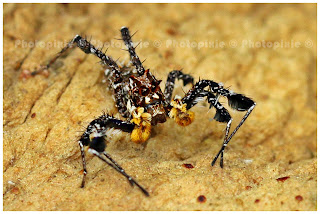 | ||||||||||||||||||||||||||||||||||||||||||||||||||||||||||||||||||||||||||||||||||||||
| Silhouette of Robber Fly |
 | ||||||||
| Sitting on a perch waiting for its next victim |
Like the praying mantis, robber flies also have 3 simple eyes (ocelli) located in the depression between the two compound eyes. Another interesting fact : A male should be vigilant when courting a female or she will fly out, stab him with her proboscis and eat him!!!
These flies are famous for catching its prey in mid-air. The mouthparts consist of a triangular proboscis which is stabbed into the prey. Enzymes are injected into the insect to liquefy the insides, so that it can be sucked up by the robber fly. Yummy!!!!
I just love the colour of the compound eyes and the white 'beard' on this insect! I'm really so glad I took an interest in photography as I'm learning more each day about mother earth and its inhabitants....
Finally, I just have to mention that my brother gave me gift vouchers from Exclusive Books for Christmas. Can't wait to visit the shop to purchase a book on South African insect and spiders. Tx, my Ironman! :D




























